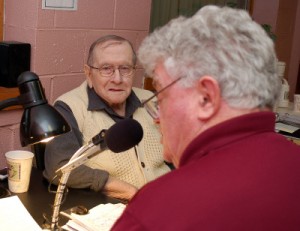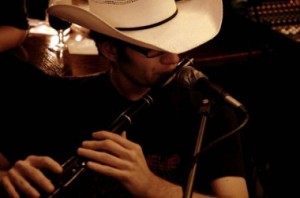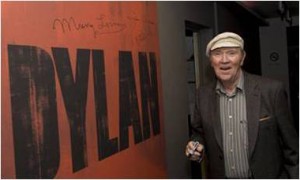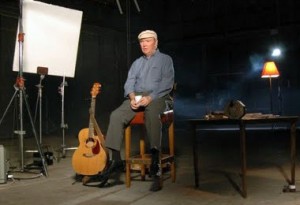
Tommy Moffit, left, with his longtime friend Vince Gallagher.
Some of Tommy’s friends shared their memories of him with us. Feel free to share yours in the comments section.
(Reported by Denise Foley, Lori Lander Murphy, and Marianne MacDonald.)
Marianne MacDonald, longtime friend, host of “Come West Along the Road,” on WTMR 800 AM
Mentor, inspiration, friend, kindred spirit… Tommy was all of these and more to me. I met Tommy over 20 years ago when I started to go to Emmett’s Place in the Northeast. Tommy played there all of the time, and my favorite time to go was always the night before Thanksgiving. The bar would be packed, there would be dozens of people trying to dance in an area barely big enough to swing a cat. Tommy would be playing away at the front of the room, telling us to keep moving, keep up with the music!
Throughout the years, Tommy and I became good friends. We worked together in different organizations and the thing that I am most glad I was able to do for Tommy was when I nominated him to (and he won) the Mid-Atlantic Comhaltas Ceoltóirí Éireann Hall of Fame. I was determined that Tommy’s work in promoting and preserving the Irish culture and music scene here in Philadelphia be recognized by as many people as possible. But Tommy never sought the limelight or needed recognition to be appreciated.
His love of traditional Irish music knew no limits. He was always willing to share a CD of an artist that I heard on his Sunday morning radio show. I used to time my Sundays so that I could listen to his entire show as I drove to Toms River to visit my parents. When Tommy would ask who the mystery singer was, I would call in as I drove and Tommy would laugh that I could talk and drive at the same time. That was always my special time to listen to Tommy and have no distractions to take me away from his voice and his music.
Tommy was always there to help out. If there was a fundraiser or an event at which he could play, he always volunteered. As he grew older and the fingers stiffened up a bit, he moved into the role of emcee. From the Wren Parties of old, to the Ceili Group festivals to benefits for friends who had fallen ill, Tommy was there to share stories, jokes and memories.
When Tommy decided it was time to retire from his radio show, I was deeply honored and touched when he asked me to take the reins. I had sat in with him several times previously, loved the easy way he bantered with his audience and the incredible knowledge of the music he played and loved. How could I possibly fill his chair? When I finally went solo, Tommy called me during each show and told me what a good job I was doing and how much he looked forward to listening each week. He very generously offered me the opportunity to come to his apartment and go through his CDs and borrow anything that interested me. That was Tommy to the core, generous and giving always.
In 2006, I ran a tour to Ireland and was able to offer Tommy the chance to come along. He was thrilled to be touring with a group of musicians and dancers and we had a great night at the White House Hotel in Ballinlough, Co. Roscommon, when Tommy’s family came out, along with many of the locals, to pay tribute to Tommy as he performed for the ceili that evening. I remember seeing how adored Tommy was that evening as we said our farewells to the Roscommon folks as we returned to Galway.
Tommy’s tired body has gone home but his gentle spirit, kind words and twinkling wit live on here in my heart and I’m sure in the hearts of all who knew him. God bless you, Tommy Moffit. Rest in peace.
Gerry Buckley, co-founder, Comhaltas Ceoltóirí Éireann of the Delaware Valley
Tommy was a great character and one who tirelessly promoted Irish culture and pride throughout the Delaware Valley in so many different venues and was a great supporter for so many different Irish organisations. Tommy did so much to promote the cause of CCE-DV for many years as a board member and always supported and attended our events when he could. Inducted into the CCE hall of Fame in 2002 Tommy’s contributions to all the Irish groups and societies will be fondly remembered and much talked about I am sure over the next coming days and weeks. There is many the quiet reflection going on all over Philadelphia, Delaware and NJ of the many many ceilis and occasions where Tommy played his heart our and looked down at the dancers with that big wide smile. From the South Jersey Irish Society in Palmyra to Trenton to Sr Pegs Ceilis, to DE ceilis, to the Timoney ceilis, PCG events, Irish Center, down the shore, Bucks County to the local Irish pub session or gathering one person could be relied to be there when he could and that was Tommy. And how he graced the airwaves for so many years with his choice of great Irish traditional music. He knew the true Irish traditional style of music—he knew how much it meant to some many people and I am sure, he knew how much he was appreciated and loved by all the Irish (be they traditionalists or not). Ar dheis De go raibh a anam usuail – God rest his noble soul.
John O’Callaghan, front man for the band, Jamison
Editor’s Note: O’Callaghan wrote this about Tommy Moffit when he retired and shared it with us this week.
I just wanted to take a minute of your time to tell you about a remarkable musician, Irish radio show host, and overall individual. His name is Tommy Moffit. For the past 30 years of my life, I experienced Tommy in many facets in the Irish community. When I was a child, I can remember the many Friday and Saturday nights when my parents, aunts, uncles and most of all my grandmother would try to find a baby-sitter so they could go to Emmett’s Place to hear Tommy play and Irish dance straight into the night. At times a baby-sitter couldn’t be found and I had to go with them. To be honest, at first I was not too enthusiastic about going to a bar to hear “that Irish Stuff” at 8-9 years old, but at least I got to eat one of Emmett’s famous cheesesteaks and wash it down with an unlimited supply of soda. After a few times at Emmett’s and hearing Tommy’s band play, I was hooked. As the years went by and my family stopped going to Emmett’s, I would always look for Irish music, especially music with an accordion. I attempted (and failed horribly) to learn the accordion and settled with learning to play the guitar and sing. When I was in college, I had a job washing cars at a funeral home. Pretty easy job, and just as long as you don’t mind what goes on at a funeral home, it was good pay for kid trying to work his way through college. I remember every Wednesday afternoon, I would put on the radio just to hear the Tommy Moffit Irish Hour. My boss and co-workers thought it was uncanny and sometimes weird to have a 20-year-old college student listening to the “sweetest sound this side of Roscommon.” but hey, Tommy would give free plugs to the funeral home when I called to make a request, so they didn’t mind one bit.
As I moved into the Irish scene as a musician myself, Tommy motivated me like no other person ever had or ever will. I can remember at the 1995 Penn’s Landing Irish Festival, Tommy’s band just finished playing and my group, Shades of Green, were up next. We were very nervous and instead of enjoying the time on stage, we just blew by our hour set. After we finished, I remember Tommy pulling me aside, sitting me down and critiquing our set. With a pointed finger, and raised Roscommon voice, he told me “Never turn your back to the crowd” and “always know what you’ll play next,” after which he shook my hand and congratulated us on a job well done, being that it was our first time on the main stage.
One final story to tell you… Tommy was over in Roscommon at the same time Shades of Green were on a three-week tour in Ireland. Tommy and his brother drove from his hometown in Roscommon to Ballyhaunis, County Mayo to see us play. To me, that was the apex of our tour in Ireland. To have a man that I looked up to since I was a boy come and see us play, goes to show what kind of person he really is. With these experiences, I can honestly tell you Tommy can be your most fierce critic but also a truly dedicated fan.
When I was told that Tommy has retired as the host of his Irish radio show, it struck me in a sad way, and compelled me to write this article. Tommy, I just want to thank you for all the years that you have given to the Irish community through your radio show. As for me and my family, I want to thank you for the many years of music you have provided for us, as well as the guidance that you had given me as well as every Irish musician in the city of Philadelphia to strive to be at least as half as good as you are, not only as a musician, but a great person that I am happy to call my friend.
Joe O’Callaghan, friend
I’ve known Tommy for 40, 45 years. I used to love to go out Irish dancing, and I remember when he was playing with the Four Provinces Orchestra years ago. Yes, that was a long time ago! My father used to take me to see him, down at Broad and Erie.
My mother was from Ballyhaunis in County Mayo, near from where Tommy was from, and he knew a lot of my mother’s relatives. So, I’d see Tommy at a lot of my relatives’ playing. And of course, he played at Emmett’s, he played at the Irish festivals. He played at my wedding. At my wedding, when we had the reception, dinner was late getting started, and they closed the bar down. Now, I’m a non-drinker, so it didn’t worry me, but I was worried for all the guests. You’ve got 300 Irish Americans here, the dinner’s late, and the bar is closed. Tommy said to me, “Don’t worry. We’ll play some music and get them dancing.” And they did. They had everyone Irish dancing all night—more Irish dancing than any other kind. And at the end of the night, Tommy said, “We’re having such a good time, we want to play a little bit longer for you.”
He reminded me of my father, very old stock Irish… not too firm, but people always listen to ‘em. He was very generous. He was always trying to get me to sing…”You’ve got a good voice, you should sing,” he’d say. “Hey, Joey, you want to sing?” And I’d say, “Oh, no, Tommy, I‘ll leave the singing to my son.” He was very instrumental in my son John playing Irish music, which just thrilled me. I thanked him for helping John to get into the Irish music field.
He was very charitable. If anybody needed any help, he would help them. He would really go out of his way for people. And he never turned me down when I asked him to play a reel. He was very knowledgable about music. Boy, he could play some music, though. I always liked to do a good set with him.
I liked Tommy very much. I always used to enjoy when he talked about Ireland to me. He was a top gun as far as I’m concerned. He was a good gentleman, a good Christian, a good musician and a good friend. Mainly a good friend first. I think a lot of people are gonna miss him.
Emmett Ruane, former owner of Emmett’s Place in Oxford Circle, where the Tommy Moffit Band played for many years
We were together a long time. I think I met him in the late 1960’s. My wife’s family knew Tommy when he went into the bar business. We really got to know each other in 1972, that’s when he started playing at Emmett’s. He played there from ‘72 to about ‘82. Then he left… he wanted to do something else for awhile. He came back in ‘92.
He was more American than some of the Americans born here. He served in the Korean War, and he never forgot what it meant. At the holidays, we’d have an indoor picnic at Emmett’s and Tommy would be playing; he’d always wind up the dancing with “The Star Spangled Banner” and “God Bless America.” It upset him when they played the national anthem and people didn’t stand up. Sometimes he told them, too. One night at the bar when he wasn’t playing, the national anthem started playing. There were two men who had just gotten out of the Marine Corps, they still had the short haircuts, and they didn’t stand up. Tommy yelled at them, and they jumped out of their seats like two rabbits! When it was over, they came back and apologized to him. They said they hadn’t known what to do, they’d never heard it played in a bar before. Tommy reminded them—no matter where you are, you always stand. He was the most patriotic person I knew.








